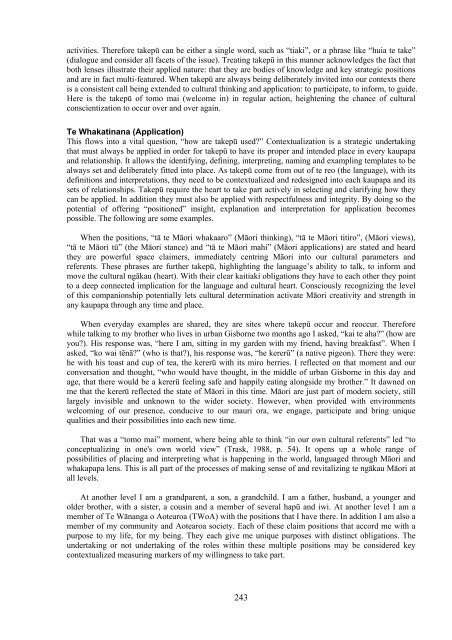traditional knowledge conference 2008 te tatau pounamu
traditional knowledge conference 2008 te tatau pounamu
traditional knowledge conference 2008 te tatau pounamu
You also want an ePaper? Increase the reach of your titles
YUMPU automatically turns print PDFs into web optimized ePapers that Google loves.
activities. Therefore takepū can be either a single word, such as “tiaki”, or a phrase like “huia <strong>te</strong> take”(dialogue and consider all facets of the issue). Treating takepū in this manner ac<strong>knowledge</strong>s the fact thatboth lenses illustra<strong>te</strong> their applied nature: that they are bodies of <strong>knowledge</strong> and key stra<strong>te</strong>gic positionsand are in fact multi-featured. When takepū are always being delibera<strong>te</strong>ly invi<strong>te</strong>d into our con<strong>te</strong>xts thereis a consis<strong>te</strong>nt call being ex<strong>te</strong>nded to cultural thinking and application: to participa<strong>te</strong>, to inform, to guide.Here is the takepū of tomo mai (welcome in) in regular action, heigh<strong>te</strong>ning the chance of culturalconscientization to occur over and over again.Te Whakatinana (Application)This flows into a vital question, “how are takepū used?” Con<strong>te</strong>xtualization is a stra<strong>te</strong>gic undertakingthat must always be applied in order for takepū to have its proper and in<strong>te</strong>nded place in every kaupapaand relationship. It allows the identifying, defining, in<strong>te</strong>rpreting, naming and exampling <strong>te</strong>mpla<strong>te</strong>s to bealways set and delibera<strong>te</strong>ly fit<strong>te</strong>d into place. As takepū come from out of <strong>te</strong> reo (the language), with itsdefinitions and in<strong>te</strong>rpretations, they need to be con<strong>te</strong>xtualized and redesigned into each kaupapa and itssets of relationships. Takepū require the heart to take part actively in selecting and clarifying how theycan be applied. In addition they must also be applied with respectfulness and in<strong>te</strong>grity. By doing so thepo<strong>te</strong>ntial of offering “positioned” insight, explanation and in<strong>te</strong>rpretation for application becomespossible. The following are some examples.When the positions, “tā <strong>te</strong> Māori whakaaro” (Māori thinking), “tā <strong>te</strong> Māori titiro”, (Māori views),“tā <strong>te</strong> Māori tū” (the Māori stance) and “tā <strong>te</strong> Māori mahi” (Māori applications) are sta<strong>te</strong>d and heardthey are powerful space claimers, immedia<strong>te</strong>ly centring Māori into our cultural parame<strong>te</strong>rs andreferents. These phrases are further takepū, highlighting the language’s ability to talk, to inform andmove the cultural ngākau (heart). With their clear kaitiaki obligations they have to each other they pointto a deep connec<strong>te</strong>d implication for the language and cultural heart. Consciously recognizing the levelof this companionship po<strong>te</strong>ntially lets cultural de<strong>te</strong>rmination activa<strong>te</strong> Māori creativity and strength inany kaupapa through any time and place.When everyday examples are shared, they are si<strong>te</strong>s where takepū occur and reoccur. Thereforewhile talking to my brother who lives in urban Gisborne two months ago I asked, “kai <strong>te</strong> aha?” (how areyou?). His response was, “here I am, sitting in my garden with my friend, having breakfast”. When Iasked, “ko wai tēnā?” (who is that?), his response was, “he kererū” (a native pigeon). There they were:he with his toast and cup of <strong>te</strong>a, the kererū with its miro berries. I reflec<strong>te</strong>d on that moment and ourconversation and thought, “who would have thought, in the middle of urban Gisborne in this day andage, that there would be a kererū feeling safe and happily eating alongside my brother.” It dawned onme that the kererū reflec<strong>te</strong>d the sta<strong>te</strong> of Māori in this time. Māori are just part of modern society, stilllargely invisible and unknown to the wider society. However, when provided with environmentswelcoming of our presence, conducive to our mauri ora, we engage, participa<strong>te</strong> and bring uniquequalities and their possibilities into each new time.That was a “tomo mai” moment, where being able to think “in our own cultural referents” led “toconceptualizing in one's own world view” (Trask, 1988, p. 54). It opens up a whole range ofpossibilities of placing and in<strong>te</strong>rpreting what is happening in the world, languaged through Māori andwhakapapa lens. This is all part of the processes of making sense of and revitalizing <strong>te</strong> ngākau Māori atall levels.At another level I am a grandparent, a son, a grandchild. I am a father, husband, a younger andolder brother, with a sis<strong>te</strong>r, a cousin and a member of several hapū and iwi. At another level I am amember of Te Wānanga o Ao<strong>te</strong>aroa (TWoA) with the positions that I have there. In addition I am also amember of my community and Ao<strong>te</strong>aroa society. Each of these claim positions that accord me with apurpose to my life, for my being. They each give me unique purposes with distinct obligations. Theundertaking or not undertaking of the roles within these multiple positions may be considered keycon<strong>te</strong>xtualized measuring markers of my willingness to take part.243
















